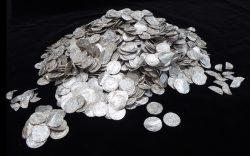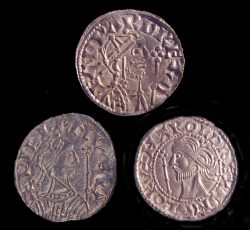 AN unprecedented hoard of 2,584 silver coins from the time of the Norman Conquest, found by metal detectorists in the Chew Valley, has been saved for the nation, and will have a permanent home in the Museum of Somerset, after being exhibited at the British Museum and in museums across the country.
AN unprecedented hoard of 2,584 silver coins from the time of the Norman Conquest, found by metal detectorists in the Chew Valley, has been saved for the nation, and will have a permanent home in the Museum of Somerset, after being exhibited at the British Museum and in museums across the country.
The acquisition of this remarkable find by the South West Heritage Trust is the highest value treasure on record. The funding for the purchase includes £4.4 million from the National Lottery Heritage Fund, £150,000 from the Art Fund, alongside smaller but vital grants from the Friends of The Museum of Somerset and the Somerset Archaeological and Natural History Society..
The coins date from the period C1066-68, and were probably buried for safekeeping in the turmoil of the Conquest. The hoard has been valued at £4.3 million. From 26th November, coins from the hoard will go on display at the British Museum. They will later be exhibited across the UK, including in Bath, before finding a permanent home in Taunton.
The hoard is one of the most remarkable finds reported under the Treasure Act 1996, administered by the Treasure Registry at the British Museum on behalf of the Department for Culture Media and Sport. It was discovered on 26th January 2019 by seven finders while metal detecting in the Chew Valley. They reported the find via the British Museum’s Portable Antiquities Scheme, which records archaeological finds made by the public and also handles the local reporting of treasure finds.
 The hoard comes from a turning point in English history. It covers the transition from Saxon to Norman rule marked by 1066 and was probably deposited for safekeeping during rebellions in the south west against the new Norman king, William I (the Conqueror). It is recorded that “Exeter was the first town to fight for its liberty” against Norman rule. Harold II (1066) the last crowned Saxon king of England is represented on just under half the coins, while the new Norman rules is shown on just over half.
The hoard comes from a turning point in English history. It covers the transition from Saxon to Norman rule marked by 1066 and was probably deposited for safekeeping during rebellions in the south west against the new Norman king, William I (the Conqueror). It is recorded that “Exeter was the first town to fight for its liberty” against Norman rule. Harold II (1066) the last crowned Saxon king of England is represented on just under half the coins, while the new Norman rules is shown on just over half.
Heritage Minister, Sir Chris Bryant said: “This remarkable hoard gives us unique insight into our country’s rich history and one of the most important moments, when these islands were thrown into turmoil by the Norman Conquest. The Treasure Act 1996 ensures that these coins, dating back to 1066, will be displayed in museums across the UK before residing in Somerset, giving people from different regions the opportunity to see this extraordinary treasure, learn more about our past and protect this part of our heritage for future generations.”
 Sam Astill, chief executive of the South West Heritage Trust said: “The hoard symbolises a pivotal moment in English history and we are delighted to have made this acquisition so that it may be enjoyed by generations to come. It highlights the power of museums, collections and stories to inspire people and communities and has been made possible thanks to a wide range of partners working together to ensure our heritage is protected and accessible for everyone.”
Sam Astill, chief executive of the South West Heritage Trust said: “The hoard symbolises a pivotal moment in English history and we are delighted to have made this acquisition so that it may be enjoyed by generations to come. It highlights the power of museums, collections and stories to inspire people and communities and has been made possible thanks to a wide range of partners working together to ensure our heritage is protected and accessible for everyone.”
The Heritage Lottery grant will help to fund a permanent home for the hoard at the Museum of Somerset.
Photographs of the Chew Valley Hoard, © British Museum; photograph of South West Heritage Trust curator Amal Kreisheh © SWHT